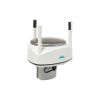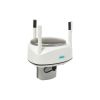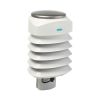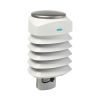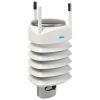Vaisala WXT531 Rainfall Sensor
Features
- Low power consumption is ideal for battery powered systems
- No moving parts for durability and long maintenance intervals
- Easy integration with 3rd party data collection platforms
- Free ground shipping
- Expedited repair and warranty service
- Lifetime technical support
- More
Flexibility
The WXT530 is a series of weather instruments that provides six of the most important weather parameters, which are air pressure, temperature, humidity, rainfall, wind speed and direction through various combinations. Select the transmitter with the needed parameter(s) for specific weather applications, with a large variety of digital communication modes and a wide range of voltages. There is a heated option available. Low power consumption enables solar panel applications. The Vaisala WXT530 Series focuses on maintenance-free operations in a cost-effective manner.
Integration
The series offers analog input options for additional third-party analog sensors. With the help of the built-in analog to digital converters, the Weather Transmitter WXT530 turns into a small, cost-effective weather parameter hub. Additional parameters include the solar radiation and external temperature sensor. Further, the analog mA output option for wind speed and direction enables a wide variety of industrial applications. The WXT530 exceeds IEC60945 maritime standard.
Solid Performance
The WXT530 Series has a unique Vaisala solid-state sensor technology. To measure wind, the ultrasonic Vaisala WINDCAP Sensors are applied to determine horizontal wind speed and direction. Barometric pressure, temperature, and humidity measurements are combined in the PTU module using capacitive measurement for each parameter. This module is easy to change without any contact with the sensors. The precipitation measurement is based on the unique acoustic Vaisala RAINCAP Sensor without flooding, clogging, wetting, and evaporation losses.
In The News
Source Water Monitoring in Albany, New York: Tracing Water Quality throughout Tributaries
Thousands of US cities pull their drinking water from natural source waters like reservoirs, rivers, and streams, making overall watershed health a key consideration for water providers. In Albany, New York, the Albany Department of Water and Water Supply delivers drinking water to over 100,000 residents as well as monitors and manages the larger drinking water supply watershed. Hannah Doherty, Environmental Specialist at the Albany Department of Water and Water Supply , spends her days working with a small team to monitor the drinking supply and the connected water bodies. Doherty explains, “We’re the first to encounter the water that ends up being the drinking water.
Read MoreWildfire Prevention in the Sierra Nevada Region with the Yuba Watershed Institute
Though recent wildfires have sparked new conversations about wildfire management and response, groups like the Yuba Watershed Institute have been monitoring the forests and water resources of the Sierra Nevada region for decades, managing approximately 5,000 acres of land with the Bureau of Land Management (BLM) and about 7,000 acres in private land partnerships. The goal of the Institute is to work with local communities and land agencies to improve watershed and forestry management through informed practices and public outreach. The goals of the Yuba Watershed Institute are three-fold: Improve the ability of fire suppression agencies like the California Department of Forestry and Fire Protection ( CAL FIRE ) and the US Forest Service.
Read MoreWave Sensors Integration with NexSens Buoys: A Cutting-Edge Solution for Wave Measurment
Real-time wave data supports accurate weather prediction, safe and efficient maritime operations, and provides valuable safety and operating condition information for recreation and commercial fishing. Understanding wave dynamics also helps with the design of protective coastal structures like seawalls, breakwaters, and jetties. It also supports better prediction of their impact on sediment transport and coastal geomorphology. Wave data is a key factor in qualifying and designing offshore wind farms and harnessing kinetic energy for electrical generation. It helps with the understanding of ocean-atmosphere interactions and contributes to studies of sea-level rise and climate change impacts.
Read More















